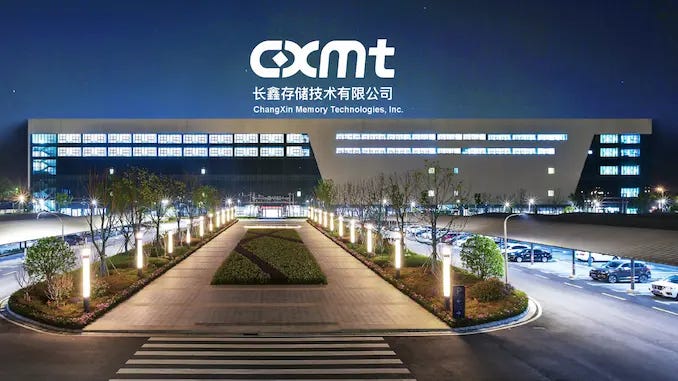When Government Plays VC: Why Smart Money is Getting Nervous About China's Hefei Model
Hefei's state-led VC model created giants like NIO and CXMT. But is it sustainable? This piece analyzes the model's core mechanism, the immense financial and geopolitical risks, and what it all means.
Hello China Tech by Poe Zhao – Weekly insights into China’s tech revolution. I analyze how developments in Chinese AI, electric vehicles, robotics, and semiconductors are reshaping global technology landscapes. Each piece contextualizes China’s innovations within worldwide market dynamics and strategic implications.
Inside the financial machinery behind China’s $21B memory chip bet–and the growing cracks that could bring it all down.
Last week, we explored how Hefei transformed from a sleepy provincial capital into a high-tech powerhouse, nurturing companies like BOE, NIO, and now the $21 billion memory chip champion CXMT. But the real story isn’t just about individual companies–it’s about a radical reimagining of how government and capital work together.
As CXMT prepares for its landmark IPO, global investors are essentially betting on more than just a semiconductor company. They’re betting on the sustainability of an entirely new model of state capitalism. Three key questions for investors: How does this model actually work? What are the real risks? And most importantly–how do you evaluate Chinese companies that emerge from this system?
From Landlord to Lead Investor: Decoding the Mechanism
At its core, the Hefei Model represents a fundamental shift in the fiscal architecture of local governance in China. For decades, economic development followed a familiar script: “attracting merchants and bringing in capital” (zhaoshang yinzi). Local governments competed in a race to the bottom, offering ever-cheaper land, tax breaks, and subsidies. The government’s role was that of a landlord, generating revenue primarily from leasing land to factories and property developers.
The Hefei Model turns this logic on its head, moving from “element-based attraction” to “capital-based attraction.” Instead of simply providing the elements for production (land, labor), the government becomes an active shareholder. The core mechanism is what officials call “invest-to-attract” (yi tou dai yin).
The key actors in this new drama are the sprawling state-owned entities known as Local Government Financing Vehicles (LGFVs). Once tasked with the mundane work of building roads and bridges–and accumulating mountains of debt in the process–they have been repurposed into powerful investment arms. They operate sophisticated industrial funds, identifying strategic companies and taking significant equity stakes, using that investment as a powerful lure to anchor an entire industry and its supply chain within the city’s borders.
For investors, this creates a unique due diligence challenge. When evaluating companies like NIO or CXMT, you’re not just analyzing a business–you’re analyzing the sustainability of an entire financing ecosystem that has no Western equivalent.
The theoretical goal is a self-sustaining “virtuous cycle”:
Invest: The government’s industrial fund identifies and takes an equity stake in a strategic “anchor” company (like BOE or NIO).
Attract: The anchor company’s presence creates a gravitational pull, attracting a constellation of upstream suppliers and downstream customers, forming a robust industrial cluster.
IPO & Exit: The anchor company succeeds and goes public. The government fund exits part or all of its position at a significant profit.
Reinvest: Those profits are then recycled back into the fund, providing the capital for the next strategic bet on a new industry.
This system is lubricated by two factors private capital often lacks. The first is a unique talent engine. The unglamorous city is home to the University of Science and Technology of China (USTC), one of the nation’s most elite engineering institutions. It functions as an anchor for talent and alumni networks, much as Carnegie Mellon did for Pittsburgh’s tech renaissance. CXMT’s founder, Zhu Yiming, is a prime example of the talent the city can attract and retain.
The second, and more crucial, factor is the nature of its capital. Unlike private venture funds facing pressure from limited partners for quarterly returns, Hefei’s state funds can deploy “patient capital.” They can withstand the long, cash-burning development cycles and cyclical downturns that are characteristic of capital-intensive “hard tech” industries. CXMT’s government backing gives it patient capital for the 5–7 year cycles that break private investors, but also creates long-term competitive distortions that worry global players.
Cracks in the Empire: Why Smart Money is Getting Nervous
For all its triumphs, the Hefei Model is walking a tightrope over a chasm of risk. Its success is shadowed by deep structural vulnerabilities that could not only derail the city but also create systemic problems for China’s broader economy.
Financial Sustainability: When Patient Capital Becomes Impatient
The most immediate and severe threat is financial sustainability. The model’s engine runs on government capital, yet its traditional wellspring—revenue from land sales to property developers—has collapsed. This financial pressure is acute: the city’s investment vehicles (LGFVs) are already burdened by immense legacy debt, even as their primary funding source plummeted by 38% in 2023.
This creates a dangerous paradox: just as the city needs its investment arms to be more active than ever to pivot the economy, their primary funding source is drying up. The LGFVs being used as investment vehicles are already laden with trillions of yuan in legacy debt from their past infrastructure-building sprees. Pouring more borrowed money into high-risk, long-gestation tech ventures is a precarious strategy. As one local business owner bluntly put it to the New York Times in early 2024, “The government has no money, its pockets are empty.”
When the primary source of “patient capital” becomes impatient, what happens to the companies that depend on it?
Destructive Duplication: Racing to the Bottom at Scale
The second major risk is the looming specter of destructive duplication. The very success of Hefei has triggered a nationwide frenzy of imitation. Dozens of other cities are now scrambling to replicate its playbook, establishing their own industrial funds and pouring state-backed capital into the same handful of hot sectors–EVs, batteries, and semiconductors.
This has already triggered vicious price wars and severe overcapacity in the electric vehicle industry, threatening to turn a promising sector into a money-losing quagmire. A senior official from China’s central government has publicly warned against this “blind launching and redundant construction of projects.” When every local government wants its own NIO or CXMT, the result is not a healthy ecosystem, but a wasteful, state-sponsored race to the bottom that misallocates vast sums of capital.
For investors, this creates sector-level overcapacity risk that transcends individual company fundamentals. Even well-managed companies can be destroyed by supply-demand imbalances created by dozens of government-backed competitors.
Geopolitical Headwinds: When Success Becomes a Target
Finally, the model is colliding with powerful geopolitical headwinds. Its state-centric nature, a source of strength domestically, is viewed with deep suspicion abroad. The deep entanglement of government funds and strategic direction in companies like NIO and CXMT provides ready-made ammunition for foreign governments arguing that China is engaged in unfair competition.
The European Union is already conducting anti-subsidy investigations into Chinese EVs. For a company like CXMT, which operates in a sector at the very heart of the U.S.-China tech rivalry, its state-backed origins and national-champion status make it a clear target for further trade restrictions, technology sanctions, and investment blacklists that could cripple its access to global markets and critical technologies.
This matters particularly for memory chips, where success depends on access to the most advanced manufacturing equipment–much of which is controlled by U.S. and Dutch companies already subject to export restrictions.
Investment Implications: A New Framework for China Tech
The Hefei Model is undeniably one of the most important economic experiments happening in the world today. It is a sophisticated evolution of state capitalism, one that has successfully nurtured genuine innovation and built globally competitive industrial clusters. Its longevity and adaptive nature–learning from the 2007 shipbuilding failure, mastering the BOE deal, and applying the lessons to NIO and CXMT–cannot be dismissed as a simple fluke.
Yet, as the CXMT IPO approaches, the model stands at a crossroads, built on a precarious foundation of state-directed credit and now facing the dual headwinds of a domestic property bust and rising international protectionism. The $21 billion valuation is a bet that CXMT can not only survive but thrive on the global stage, generating the returns necessary to validate the massive public investment that created it.
For investors, three key takeaways emerge:
Due diligence framework: When evaluating Chinese tech companies, especially those emerging from government-backed ecosystems, traditional financial analysis isn’t enough. You need to evaluate:
The sustainability of government backing (fiscal health of backing entities)
Sector overcapacity risk from copycat government programs
Geopolitical exposure and potential for sanctions/restrictions
Exit strategy considering government stake retention
Timing matters: The model’s current stress points suggest a narrowing window for optimal entry/exit decisions. Early government exits (like with BOE and NIO) have been profitable, but as fiscal pressures mount, future exits may be more challenging or government stakes may need to be held longer.
Diversification risk: As dozens of cities copy Hefei’s playbook, sector overcapacity becomes a systemic risk rather than a company-specific one. Portfolio construction needs to account for correlated government intervention across multiple holdings.
For Hefei, and for China, the CXMT IPO is not a finish line. It is a strategic resupply, a way to tap public markets for the immense capital needed to continue the relentless, expensive fight for technological supremacy. The final verdict on the Hefei Model is not yet in. Its outcome will determine whether China has truly forged a new, sustainable path to prosperity, or is simply telling an old story of state-driven growth, this time with microchips instead of skyscrapers.
Whether you’re investing in Chinese tech or competing against it, understanding this model isn’t optional anymore. The world will be watching to see if this “Hefei kid,” born of state ambition and entrepreneurial drive, can pass its ultimate test.
About Hello China Tech
I’m Poe Zhao, and I bridge the gap between China’s rapidly evolving tech ecosystem and the global community. Through Hello China Tech, I provide twice-weekly analysis that goes beyond headlines to examine the strategic implications of China’s technological advancement.
Found this useful?
→ Share this newsletter with colleagues who need to understand China’s tech impact
→ Subscribe for free to receive every analysis:
→ Follow the conversation on 𝕏 for daily updates and additional insights
Get in touch: Have questions about China’s tech sector or suggestions for future analysis? Reply to this email – I read every message.








